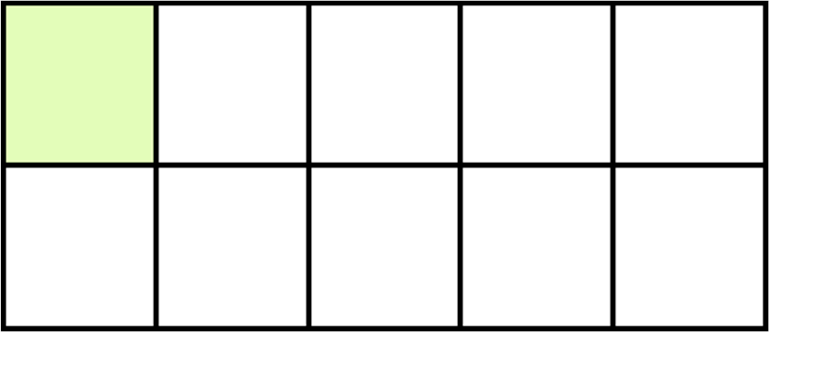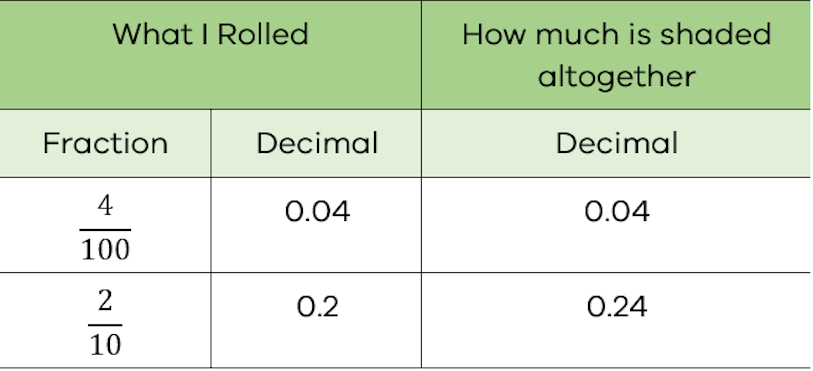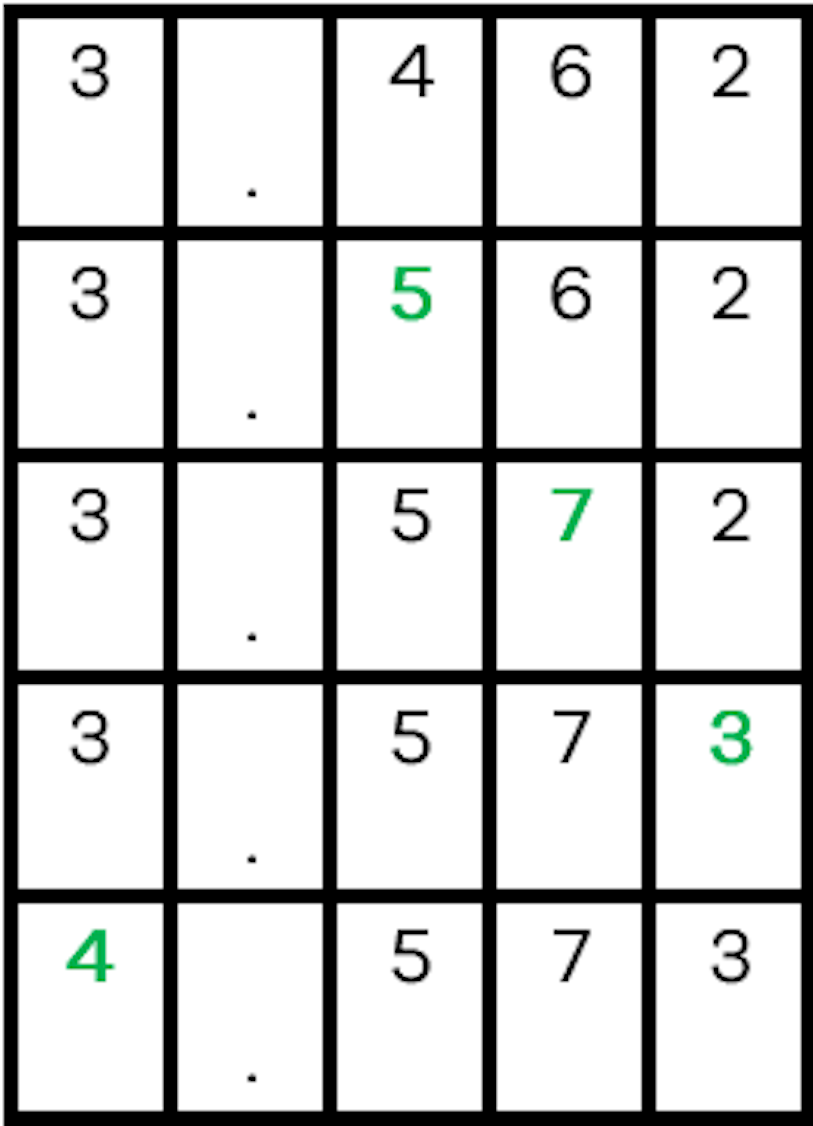Suggested Learning Intentions
- To understand place value in decimals
- To understand how place value determines the size of a decimal
Sample Success Criteria
- I can accurately colour decimals on a decimat to demonstrate place value
- I can order decimals correctly on a number line
- I can use different manipulatives to model and explain my solutions and thinking
This stage has been inspired by the ‘Colour in decimats’ problem published by Clarke and Roche (2014), and is reproduced with permission.
‘Colour in decimats’ provides a visual representation of decimals to help students make sense of decimal size and decimal place value. This game uses the decimat which is a proportional model that represents the size of decimals as parts of a whole.
Before playing the game, show the class an enlarged decimat (or an online version). Explain that a decimat is a large rectangle that represents one whole which can be divided into smaller rectangles. Divide it into 10 smaller rectangles as shown below. Ask students to tell you what each of these 10 rectangles is called. Students should be able to name these as tenths. Shade one of the rectangles and discuss that this is one tenth.

If we then divide the green rectangle into ten equal parts, and colour in one of the even smaller rectangles, what do we call this new rectangle? For discussion purposes this smaller rectangle is shaded blue as shown below.
Students may be able to answer hundredths. If not, you could ask: “If we divide each of the 10 smaller rectangles into 10 equal parts, how many smaller rectangles do we have now?”
Students should be able to calculate ten lots of 10 (or 10 x 10) to see that there are 100 smaller rectangles. So the small blue rectangle represents one hundredth.

Colour the remaining nine smaller rectangles so that the entire larger rectangle is blue. Ask students to name the coloured part. Some students may say ten hundredths. Others may see that this is the same as the first rectangle that was shaded and therefore call it one tenth.

At this point, ask students to compare one green rectangle and one blue rectangle (from each of the two diagrams shown above) and state what they notice. How much bigger is the green rectangle compared to the blue one? How many blue rectangles will make one green rectangle? We want students to see that one tenth is ten times bigger than one hundredth.
Ask further questions to build student understanding. For example:
- 'If I shaded four tenths, how many hundredths would this be?' You may need to shade this for students to visualise. We want them to see that four tenths is the same as forty hundredths.
- 'If I shaded five hundredths, how many tenths would this be? What if I took one of the blue rectangles that is divided into hundredths and then divide this into 10 equal parts again. What would we call each of these new rectangles?' Students may not have been introduced to thousandths at this level so they may need prompting to name these as thousandths.
Discuss the size of each of these divisions. For example:
- the first time the whole rectangle is divided into 10 equal parts, we have created tenths
- when one tenth is divided again into 10 equal parts, we have created hundredths
- when we divided one hundredth into 10 equal parts again, we have created thousandths.
It is important for students to understand that one tenth is larger than one hundredth, and one hundredth is larger than one thousandth.
Gauge student understanding by showing different visual representations of fractions and ask students what fraction is shaded and how this can be written as a decimal.
For example:

Now move from the visual representation to the written representation. 'How can we write three tenths? How can we write thirty hundredths? What about three hundred thousandths?' Students may come up with ³/₁₀, ³⁰/₁₀₀ and ³⁰⁰/₁₀₀₀ respectively.
Review the meaning of the terms numerator and denominator using models or diagrams to enable students to understand these written fractions.
Now ask students 'How can we write each of these fractions as decimals?' Students may know that ³/₁₀ can be written as 0.3, and ³/₁₀₀ can be written as 0.03.
Review the place value of decimals and in particular the importance of the zero as a place holder:
- The zero holds the place between a digit and the decimal point. For example, in the number 2.06 the zero holds the tenths place so that the 6 appears in the hundredths place. There are zero tenths in 2.06.
- The zero is not needed as a place holder when it is not between a digit and the decimal point. For example, 4.50 and 4.5 are the same.
Using fractional language encourages students to consolidate their knowledge and understanding of converting a fraction to a decimal. Prior to level 5, students may have only been exposed to decimals up to hundredths so decimals beyond hundredths may be new learning.
Extend students with more challenging examples, asking them to write the shaded part as a fraction and decimal.

|
Answer for blue-shaded shape: This shape is divided into hundredths and there are 36 of these shaded so the fraction is ³⁶/₁₀₀. This would be 0.36 as a decimal. |
Answer for green-shaded shape: In this shape there are six tenths and three hundredths shaded. The fraction shaded is ⁶³/₁₀₀ which is 0.63 as a decimal. |
Once students have a good understanding of how a decimat works, introduce the ‘Colour in decimats’ game. If students have played the ‘Colour in fractions’ game in the previous stage of this sequence, the rules will be familiar although there are some modifications. The rules are explained during the demonstration game.
The decimat game board (available in the Materials and texts section) will already be divided as shown here. The whole rectangle has been divided into tenths, then one tenth is divided into hundredths and one hundredth is divided into thousandths.

Play a few rounds with a student to explain the rules of the game. Use an enlarged copy of the decimat to demonstrate.
1. Ask the student to roll both dice to create a fraction. For example, a 4 and ¹/₁₀₀, would create ⁴/₁₀₀.
2. The student shades ⁴/₁₀₀ on their own decimat.
3. The student then fills in the first row of the Activity Sheet (available in the Materials and texts section above): 'What I rolled' as a fraction and as a decimal, and 'How much is shaded altogether'. Writing each roll as a decimal helps students connect decimals with their equivalent fractions.
4. Next it’s your turn (as second player). Record your roll on your own decimat.
5. Then the student rolls again. This time they roll ²/₁₀. They fill in their record sheet as shown.

6. Each player takes it in turns until one player has shaded their entire decimat and reaches one (or closest to one if there isn’t enough time to complete the game). Completing the game is not essential to achieve the learning intention of this activity.
One of the most important parts of the game is completing the ‘how much is shaded altogether’ column. This is an accumulated amount. That is, add the 0.2 to the 0.04 to make 0.24. Remind students, when they are working this out, to align each decimal number correctly to ensure place value is maintained to make the addition easier.
As they divide more of the tenths into hundredths and thousandths, completing this column will become increasingly harder. Encourage students to help each other with this part even though it may not be their turn.
Additional rules:
- Use a different colour to shade and record for each roll. This is mostly for checking purposes so that both players and the teacher can check that what is shaded, matches the fraction rolled.
- Each rectangle, of any size, can be further divided into smaller parts as long as those parts are of equal size. For example, if a student has shaded all of their hundredths and then rolls ³/₁₀₀, they can divide another ‘tenths’ rectangle into hundredths (i.e., divide into ten equal parts again).
Before students play the game themselves, discuss who would be the winner from the demonstration game. For example, if the student has shaded 0.45 of their decimat and the teacher has shaded 0.2. Show this visually. Who is the winner? Which is larger 0.2 or 0.45?
Students may think 0.2 is larger because they know that tenths are larger than hundredths and therefore the teacher wins. However, in this case they have not considered how many parts there are in each fraction. i.e., 0.45 has four tenths and 5 hundredths compared to 0.2 which has only 2 tenths. Therefore 0.45 is larger.
Provide another example. If the student has shaded 0.465 of their decimat and the teacher has shaded 0.76, who is the winner this time? Which decimal is larger?
Some students may think that the student is the winner since 465 is larger than 76. In this case students ignore the decimal point and think the digits after the decimal point make another whole number. Discussion to address this is important to flesh out the common misconception that ‘longer is larger’.
If the game is not completed because of time constraints, students will need to work out who has shaded more of their decimat to be declared the winner. Encourage each pair of students to justify who they think has won by comparing their decimals and writing down their explanation.
To gain maximum benefits from this game, it is recommended that students play it multiple times. If the game is played more frequently, students are more likely to understand and make sense of decimals more easily.
Enable students by removing the thousandths option from the die so that it contains only ¹/₁₀ and ¹/₁₀₀ and provide a decimat that is only divided into tenths and hundredths, to make the game more manageable. Alternatively, re-label the die to reduce the number of thousandths options and increase the tenths or hundredths options.
Extend students by relabelling the die to increase the thousandths options to 4 and reduce the hundredths option to 1. When students have completed the game, ask them to order their decimals on a number line or order them from smallest to largest. Students could also divide their thousandths even further to ten thousandths.
Upon completion of the game, ask students to reflect on what they have learned about decimals from playing this game. Possible question prompts include:
- What strategy or strategies did you use to play the game? Explain whether you think these strategies worked for you and why they worked.
- Next time you play this game what would you do differently so that you can win the game?
- Did you learn anything about decimals or fractions you didn’t know before playing this game? Explain what you learned.
By playing the ‘Colour in Decimats’ game, students have been exploring decimal place value and using this to make sense of decimal size. To consolidate student understanding you may wish to review these concepts and skills with your students.
1. Understanding place value in decimals, beyond hundredths
In the 'Colour with Decimats' game, students were introduced to thousandths. Provide a range of visual models to help students see that decimals work in the same way as fractions. Options include:
- Provide a collection of decimals, with different numbers of decimal places up to thousandths, and ask them to represent each one on a decimat and write the fraction equivalent for each decimal.
- Play a matching game using visual representations, fractions, and decimals. Students are required to match the visual representation to the equivalent fraction and decimal. Students could come up with their own matching game including the solutions. Once they have created their own game, they exchange games with a partner and complete their partner’s game. Check for student understanding by asking students to submit their completed game including their solutions.
- Ask students to write a decimal number with three decimal places. Provide students with a set of instructions to create new numbers, using their initial number as a starting point. This will show students’ understanding of decimal place value and size. Using a table may be helpful so that students line up the digits in their number correctly. A sample is provided below. This activity could be used as an exit ticket to assess understanding.
For example, students may begin with the number 3.462:
- In the second row, write the number that is one tenth more than this.
- In the next row, write the number that is one hundredth more than the previous number.
- In the next row, write the number that is one thousandth more than the previous number.
- In the last row, write the number that is one more than the previous number.

This task has been adapted from a problem available on NZMaths.
2. Locating decimals on a number line and comparing the size of decimals
The size of decimals can create some confusion for students particularly when misconceptions are not addressed adequately.
- Provide time for students to correct these misconceptions in a more contextual way. For example: 'Jay swam 0.6 km and Ruby swam 0.44 km. Ruby thinks she swam further than Jay.' Ask students to write down why they either agree with or disagree with Ruby. Share and discuss responses with the class. This will address the issue of thinking of decimals as whole numbers and ignoring the decimal point when comparing.
- The activity “Confusing Fractions and Decimals” can be used to further develop student understanding of locating a decimal on a number line. A worksheet with different number lines is included in the link.
- In the activity “Comparing Decimals: Decimal War!” students compare two decimals by using place value to determine whether one is greater than, less than or equal to the other. Instructions are provided in the link.
Clarke, D. & Roche, A., 2014. Engaging Maths: 25 Favourite Lessons. 2nd Edition ed. Melbourne: Mathematics Teaching and Learning Centre.
Education.com, n.d. Comparing Decimals: Decimal War!. [Online]
Available at: www.education.com/lesson-plan/comparing-decimals/
[Accessed 15 March 2022].
New Zealand Government, n.d. Confusing Fractions and Decimals. [Online]
Available at: nzmaths.co.nz/resource/confusing-fractions-and-decimals
[Accessed 15 March 2022].
New Zealand Government, n.d. Up and Down with Decimals. [Online]
Available at: nzmaths.co.nz/content/and-down-decimals
[Accessed 15 March 2022].
Roche, A., 2010. Decimats: Helping students to make sense of decimal place value. Australian Primary Mathematics Classroom, 15(2), pp. 4-10.
Other stages
1. Fractions as Equal Parts of a Whole
EXPLORESuggested Learning Intentions
- To understand that fractions can represent equal parts of a whole
Sample Success Criteria
- I can accurately identify the name of each fraction part
- I can correctly name fractions using the number of equal parts needed to make up the whole
- I can explain and justify my solutions using a variety of manipulatives
2. Chocolate Cake
EXPLORESuggested Learning Intentions
- To understand fractions result from division
- To compare fractions, noting how the numerator and denominator affect the size of a fraction
Sample Success Criteria
- I can identify fractions that have different names but are the same size
- I can identify which fraction is larger or smaller based on the name of the parts and how many of these parts there are
- I can justify my thinking and solutions using manipulatives or other representations
3. Fractions to Decimals
EXPLORESuggested Learning Intentions
- To estimate and locate fractions and decimals on a number line
- To understand fractions and decimals as different representations of the same number
Sample Success Criteria
- I can locate simple fractions, improper fractions, and decimals on a number line
- I can represent fractions as decimals using different models: area models, number lines and set models
- I can demonstrate my understanding using a variety of manipulatives
4. Colour in Fractions
EXPLORESuggested Learning Intentions
- To understand two fractions can be the same size but have different names
Sample Success Criteria
- I can identify fractions that are the same size but have different names
- I can make fractions that are equal in size using different parts
- I can use manipulatives to model and explain my thinking and solutions